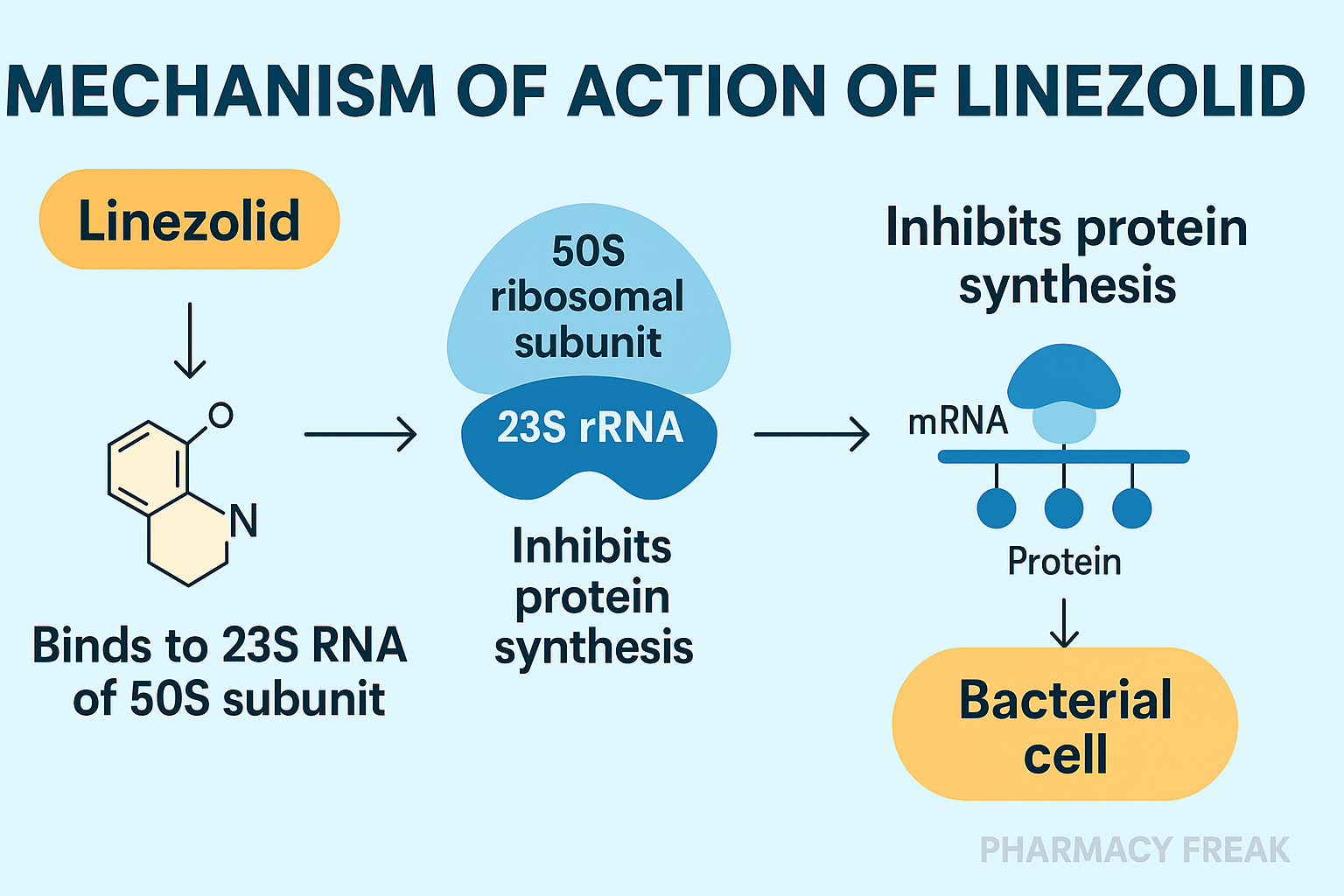Introduction
Linezolid is a synthetic bacteriostatic antibiotic belonging to the oxazolidinone class. It is primarily active against Gram-positive pathogens, including methicillin-resistant Staphylococcus aureus (MRSA), vancomycin-resistant Enterococci (VRE), and penicillin-resistant Streptococcus pneumoniae. Unlike other protein synthesis inhibitors, Linezolid binds to the 50S ribosomal subunit and blocks the initiation step of protein synthesis, making its mechanism unique and high-yield for medical exams like USMLE, NCLEX, GPAT, and NEET-PG.
Stepwise Mechanism of Action of Linezolid
- Entry into bacterial cell
Linezolid diffuses into the bacterial cell and targets the ribosome. - Binding to 23S rRNA on 50S ribosomal subunit
It specifically binds to the 23S portion of the 50S subunit of the bacterial ribosome. - Prevention of initiation complex formation
This binding inhibits the formation of the initiation complex required for protein synthesis — the step where the 30S and 50S subunits join with mRNA and initiator tRNA. - Halting of bacterial protein synthesis
As the initiation step is blocked, the translation process cannot begin, leading to bacteriostatic action. - Selective inhibition
Linezolid does not affect human ribosomes, making it selectively toxic to bacteria.
Pharmacokinetic Parameters of Linezolid
| Parameter | Value |
|---|---|
| Bioavailability | ~100% (excellent oral absorption) |
| Half-life | ~5–7 hours |
| Protein binding | ~31% |
| Metabolism | Hepatic (non-CYP enzymes) |
| Excretion | Renal and non-renal routes |
| CNS penetration | Good |
Clinical Uses of Linezolid
- MRSA infections (skin, soft tissue, pneumonia)
- Vancomycin-resistant Enterococci (VRE)
- Penicillin-resistant Streptococcus pneumoniae
- Nosocomial pneumonia
- Complicated skin and soft tissue infections
- Drug-resistant tuberculosis (off-label)
- *Alternative to vancomycin in Gram-positive sepsis
Adverse Effects of Linezolid
- Myelosuppression (esp. thrombocytopenia with prolonged use)
- Peripheral and optic neuropathy (with long-term use)
- Lactic acidosis (rare but serious)
- Serotonin syndrome (when combined with SSRIs or MAO inhibitors)
- GI upset – nausea, vomiting, diarrhea
- Headache and dizziness
Comparative Analysis: Linezolid vs Vancomycin
| Feature | Linezolid | Vancomycin |
|---|---|---|
| Ribosomal target | 23S rRNA of 50S | Peptidoglycan precursors |
| Protein synthesis step | Initiation ✅ | Not targeted |
| Spectrum | Gram-positive only | Gram-positive only |
| Oral bioavailability | High (~100%) ✅ | Poor (systemic use is IV only) |
| CNS penetration | Good ✅ | Poor |
| TDM required | No | Yes (for IV) |
Practice MCQs
Q1. Linezolid inhibits which step of protein synthesis?
a. Elongation
b. Termination
c. Initiation ✅
d. Translocation
Q2. Linezolid binds to which part of the bacterial ribosome?
a. 16S rRNA
b. 23S rRNA of 50S ✅
c. 30S A-site
d. Peptidoglycan
Q3. A major side effect with prolonged use of Linezolid is:
a. Hepatotoxicity
b. Myelosuppression ✅
c. Ototoxicity
d. QT prolongation
Q4. Linezolid is primarily used to treat:
a. Gram-negative infections
b. Fungal infections
c. Gram-positive resistant infections ✅
d. Viral pneumonia
Q5. Risk of serotonin syndrome increases with:
a. NSAIDs
b. MAO inhibitors or SSRIs ✅
c. Antacids
d. Beta-blockers
Q6. Which of the following infections is not treated with Linezolid?
a. VRE
b. MRSA pneumonia
c. Gonorrhea ✅
d. Drug-resistant TB
Q7. Linezolid should be avoided with which drug class?
a. Antipsychotics
b. SSRIs ✅
c. Diuretics
d. Antacids
Q8. What makes Linezolid unique among protein synthesis inhibitors?
a. Targets DNA
b. Inhibits initiation ✅
c. Inhibits elongation
d. Inhibits RNA polymerase
Q9. How is Linezolid administered?
a. Only IV
b. Only oral
c. Both IV and oral ✅
d. Intrathecal only
Q10. Linezolid has good penetration into which site?
a. Joints
b. CSF ✅
c. Bone marrow
d. Alveoli only
FAQs
Q1: Is Linezolid bactericidal or bacteriostatic?
It is bacteriostatic, except for Streptococcus pneumoniae, where it may be bactericidal.
Q2: Can Linezolid be given orally?
Yes, it has excellent oral bioavailability (~100%), equivalent to IV dosing.
Q3: Is Linezolid used in Gram-negative infections?
No, it lacks Gram-negative activity due to limited penetration and efflux.
Q4: What labs should be monitored with prolonged therapy?
Complete blood count (CBC) due to risk of myelosuppression.
Q5: What is the mechanism behind serotonin syndrome with Linezolid?
It is a weak MAO inhibitor, so when combined with SSRIs or SNRIs, it can cause serotonin excess.
References
- KD Tripathi – Essentials of Medical Pharmacology
- Goodman & Gilman – The Pharmacological Basis of Therapeutics
- Sparsh Gupta – Review of Pharmacology
- NCBI: https://www.ncbi.nlm.nih.gov/books/NBK534844/
I am pursuing MBA in pharmaceutical management from NIPER Hyderabad with a strong academic record and proven success in national-level pharmacy entrance exams. I secured AIR 61 in NIPER 2024 (MS/M.Pharm) and AIR 27 in NIPER MBA, along with AIR 147 in GPAT 2024 and AIR 907 in GPAT 2023. I also achieved AIR 6 in AIIMS CRE-2025 for Drug Store Keeper and was selected as a Pharmacist (AIR 61) for ESIC. Additionally, I was the Runner-Up in Round 2 of the EY Case Study Competition.
At PharmacyFreak.com, I aim to guide future pharmacists through expert content, exam strategies, and insightful resources based on real experience and academic excellence.
Mail- harsh@pharmacyfreak.com
